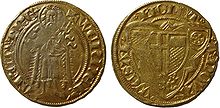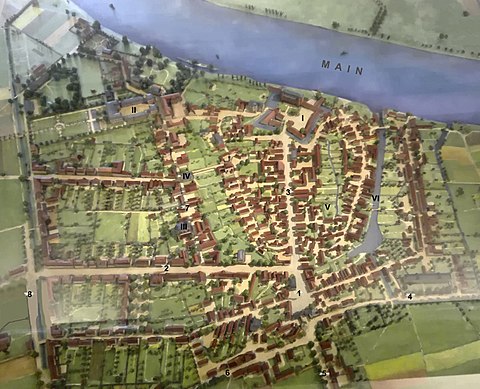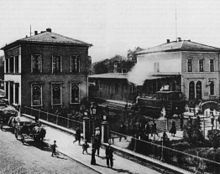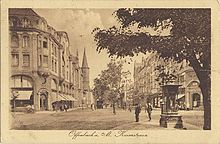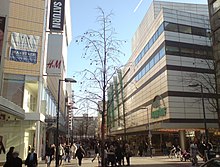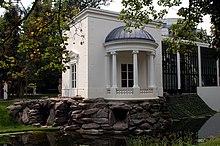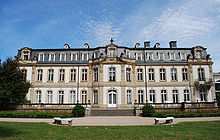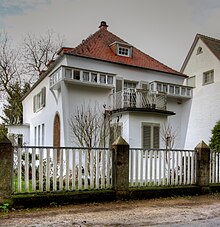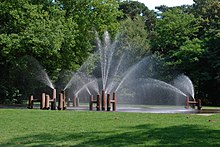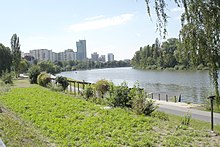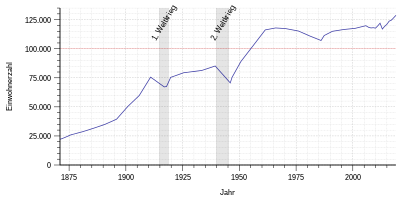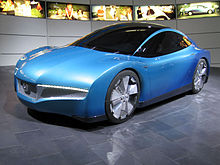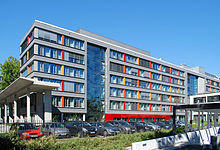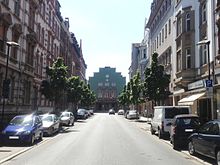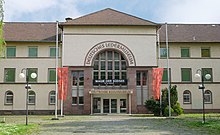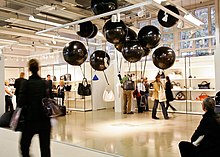Offenbach am Main
| coat of arms | Germany map | |
|---|---|---|

|
Coordinates: 50 ° 6 ' N , 8 ° 46' E |
|
| Basic data | ||
| State : | Hesse | |
| Administrative region : | Darmstadt | |
| Height : | 98 m above sea level NHN | |
| Area : | 44.89 km 2 | |
| Residents: | 130,280 (Dec. 31, 2019) | |
| Population density : | 2902 inhabitants per km 2 | |
| Postcodes : | 63065-63075 | |
| Area code : | 069 | |
| License plate : | OF | |
| Community key : | 06 4 13 000 | |
| LOCODE : | DE OFF | |
| NUTS : | DE713 | |
| City structure: | 21 districts | |
City administration address : |
Berliner Strasse 100 63065 Offenbach am Main |
|
| Website : | ||
| Lord Mayor : | Felix Schwenke ( SPD ) | |
| Location of the city of Offenbach am Main in Hesse | ||

Offenbach am Main is with 130,280 inhabitants (December 31, 2019) the fifth largest Hessian city and one of ten regional centers in Hesse . The independent city is located in the Rhine-Main area and borders directly on Frankfurt am Main , with which it is cooperatively connected via the FrankfurtRheinMain regional association.
The originally Huguenot -influenced industrial city was primarily known as the center of the leather goods industry. Today Offenbach is an important service center and with the University of Design (HfG for short) a university location with high cluster formation in the design sector. In addition, the headquarters of the German Weather Service is located in Offenbach .
Surname
Offenbach was founded after the Frankish division of the empire in 561 . The place name has a typical ending on "-bach" for this time. The origin has not been finally clarified. A derivation from a furnace (at the tube mill, the later location of the Oehler tar paint factory , a Roman lime distillery is assumed) or the open brook is considered unlikely in place name research.
According to another opinion, the place name is associated with the personal name Ovo . The name is more likely derived from Ave (from Old High German : Aue ), to Auenbach .
geography
Geographical location
The village is located on the south and south-east bank of the Main on the Mainbogen , opposite the Frankfurt districts Ostend and Fechenheim and east of the Frankfurt districts Oberrad and Sachsenhausen . This location means that the two major cities now form a contiguous settlement area. The Bieber and Hainbach streams flow through the city. Offenbach is on the Hessian apple wine and orchard route . The built-up urban area is predominantly in the north of the district , in the south there is a large forest area and the highest point of the city is 166 m on the Schneckenberg , the lowest point is 97 m above sea level. NHN in front of Isenburg Castle on the banks of the Main.
climate
The climate in Offenbach am Main is warm and temperate. Offenbach am Main receives a significant amount of rainfall during the year. This also applies to the driest month. The average annual temperature in Offenbach am Main is 10.0 ° C. About 650 mm of precipitation falls annually.
| Offenbach am Main | ||||||||||||||||||||||||||||||||||||||||||||||||
|---|---|---|---|---|---|---|---|---|---|---|---|---|---|---|---|---|---|---|---|---|---|---|---|---|---|---|---|---|---|---|---|---|---|---|---|---|---|---|---|---|---|---|---|---|---|---|---|---|
| Climate diagram | ||||||||||||||||||||||||||||||||||||||||||||||||
| ||||||||||||||||||||||||||||||||||||||||||||||||
|
Average monthly temperatures and rainfall for Offenbach am Main
|
|||||||||||||||||||||||||||||||||||||||||||||||||||||||||||||||||||||||||||
City structure
Districts
For a long time Offenbach was only partially divided into districts . Large parts of the core area were free of districts. In 2010, the eastern inner city was first named as a district and was given the name Mathildenviertel. This name was already used in part by citizens. In July 2019, the entire district-free area was divided into a further eleven districts.
The city area has since been divided into 21 districts (district number plus district):
|
|
|
Three of the districts mentioned were previously independent municipalities: Bürgel was incorporated into Offenbach on April 1, 1908, Bieber on April 1, 1938 and Rumpenheim on April 1, 1942.
Within the individual city districts there are quarters and settlements that are not officially regarded as a separate unit, but form a unit geographically or in terms of urban planning. These include the Hans-Böckler settlement in Bürgel, the Eschig on Mühlheimer Strasse, An den Eichen south of Mühlheimer Strasse and belonging to Waldheim, and Bieber-Waldhof .
Statistical districts
For statistical reasons, the city is divided into statistical districts , each of which is numbered. The districts are structured as follows (as of December 2015):
|
|
|
Neighboring communities
The city borders in the west and north on Frankfurt am Main , in the northeast on the city of Maintal ( Main-Kinzig-Kreis ), in the east on the cities Mühlheim am Main and Obertshausen (both districts Offenbach ), and in the south on the cities Heusenstamm and Neu-Isenburg (both Offenbach district).
City forest
The Offenbacher Stadtwald extends as a closed forest area in the south of the city from Heusenstamm via Gravenbruch to Obertshausen. In the east of Offenbach there is another part of the forest, the Lohberg. The city forest extends over an area of 1,330 hectares, 1,256 hectares of which are tree-covered. About 54% of the forest area is covered with pines , 21% with beeches and 14% with oaks . A district forester is located on the edge of the Bieber district, the forest authority is the Langen Forestry Office.
During the Second World War , sham villages were created in the city forest , which were intended to divert the bombing attacks from the city. Bomb fragments in older trees still bear witness to numerous misguided bomb drops.
history
Early history
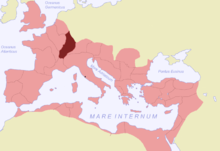
During excavations in the Offenbach area, finds from the Stone Age were made. However, it cannot be assumed that there was a continuity between the Stone Age people and the Franconian settlement.
As early as Roman times, a Roman road ran through the Offenbach area via Offenbach (Bernardstraße) to a presumed Roman bridge in Bürgel and on via Mühlheim am Main to Steinheim . Roman traces can also be found in Bieber and Offenbach-Bürgel. Roman roads also traversed the Offenbach district and presumably crossed at Bieber ("Indian Path"). The area belonged to the Roman Civitas Auderiensium in the province of Upper Germany .
From the 6th or 7th century a Franconian row cemetery has been preserved south of the oldest town center on Waldstrasse.
middle Ages
As early as the years 770 (for Rumpenheim ), 790 ( Bürgel ) and 791 ( Bieber ), the first documentary mentions of the present-day districts that were incorporated in the 20th century can be found . The city of Offenbach was first mentioned in a document on April 12, 977: Emperor Otto II notarized a donation in Offenbach to the Salvatorkirche (later the cathedral ) in Frankfurt am Main.
The place used to be part of the Maingau and the surrounding forests belonged to the Dreieich Wildbann . He maintained one of his 30 game drives in Offenbach . Offenbach was part of the Biebermark from the Middle Ages until 1819 .
Offenbach changed hands several times over the centuries. One of the first owners were the lords of Hagen-Münzenberg , who owned Offenbach because of their office as the Reich governor of Dreieich. With the Munzenberg inheritance in 1255 Offenbach fell to the Lords of Falkenstein . In 1372 Offenbach was pledged to the City Council of Frankfurt by Count Philipp von Falkenstein for 1000 guilders . Werner III. von Falkenstein , Archbishop of Trier and as Falkensteiner sovereign in Offenbach, had a castle built on the Main around 1400 and coins minted. The city of Frankfurt felt provoked by this and protested against it. When the Falkenstein inheritance was divided in 1433, Offenbach fell to Sayn and Isenburg . In 1446 Count Dieter von Sayn sold the Sayn share to Count Reinhard II von Hanau . When the County of Hanau-Babenhausen was split off from what was later known as the County of Hanau-Munzenberg in 1458, the half due to Hanau fell to Offenbach, like all Hanau properties south of the Main, to Hanau-Babenhausen. In a comparison between Hanau-Babenhausen and Isenburg, the Hanau share in Offenbach in 1500 was assigned to Isenburg.
Isenburg residence
Offenbach served as a residence for the noble family under Count Reinhard von Isenburg-Birstein. They had the Isenburg Palace built. The Reformation was introduced in Offenbach in 1559 . During the Thirty Years' War , the Bavarian occupation of Offenbach was expelled from the Swedes in 1631 and King Gustav Adolf accepted the capitulation of the imperial city of Frankfurt in the palace .
In 1698, Count Johann Philipp von Isenburg-Offenbach accepted Huguenot refugees in the village, they founded their own community west of the existing one. Thus the village of Offenbach grew to a minority . This western part developed in the course of the 18th century the city . The Huguenots brought the knowledge of tobacco processing to Offenbach and thus opened up a growth market of the 18th century.
Since Frankfurt did not allow freedom of trade , the manufacturers migrated over the then state border to Offenbach, where they were given a shelf by the Isenburgers who were friendly to trade .
In 1739 the foundation stone was laid for the Lutheran Church - today's Evangelical City Church - and in 1768 Aliceplatz, which has had this name since 1879, is laid out as a new market square. In the meantime it was called Paradeplatz because the Isenburg soldiers held exercises on it.
The poet Goethe came regularly to Offenbach in 1775, as his fiancée Lili Schönemann lived here. During this time the leather goods manufacturing began and the first industries and trades settled. Niccolò Paganini and Wolfgang Amadeus Mozart visited the emerging industrial city several times. The first to acquire the musical strings produced here by Pirazzi , the second had his sheet music published by Johann André . In 1786 the family of the writer Sophie von La Roche settled in Domstrasse 23, in 1788 the religious leader Jakob Joseph Frank in Isenburg Castle. In 1792 Austrian troops cross the Main near Offenbach and defeat the French near Höchst. In 1794 serfdom was lifted by Prince Wolfgang Ernst von Isenburg. Catholics were allowed to worship in Offenbach for the first time in over 200 years, and in 1803 Prince Carl Ludwig Moritz was one of the first to abolish the body tax for Jews.
The last execution took place in Offenbach in 1812, the gallows stood at Hermannstrasse and Schäferstrasse.
19th century
I : Isenburg Palace
II : Büsing-Palais
III : Evangelical City Church
IV : Franz-Reformed Church
V : City Cemetery (today: Wilhelmsplatz)
VI : Large beer grounds
1 : Marktplatz
2 : Frankfurter Gaß (today: Frankfurter Straße )
3 : Schlossgasse (today: Schlossstraße)
4 : Road from Nuremberg to Frankfurt (today: Bieberer Straße )
5 : Road to Darmstadt (today: Waldstraße)
6 : Road from Frankfurt to Nuremberg (today: Geleitstraße)
7 : Herrngasse (Herrnstraße)
8 : Kanalstraße (today: Kaiserstraße )
The first commercial application of lithography took place in Offenbach am Main in 1799 , after the music publisher Johann Anton André von Alois Senefelder had acquired the patent right for the "... ability to print secrets, notes and pictures on stone ..." in order to use the new method for printing notes to use. Senefelder himself set up the first five lithographic presses in Offenbach and personally instructed the employee André on the use of the machines. André recognized the importance of the invention and shortly afterwards, in 1800, had his brothers set up branches of the publishing house - while safeguarding the patent rights there - in Paris and London. Mozart's piano concertos appeared in Offenbach am Main as the first lithographic sheet music prints from 1800. After the Congress of Vienna in 1815, Prince Carl von Isenburg lost his sovereignty due to his proximity to Napoleon I. The city briefly belonged to the Archduchy of Austria and finally fell to the Grand Duchy of Hesse in 1816 . After the dissolution of the Biebermark in 1819, the city received a share of 1733 acres in the area between Hainbach and today's Grenzstraße. Since then the city has been able to expand to the east. Before that, growth was only possible to the west or south.
In 1828 the Grand Duchy of Hesse joined the Prussian customs area, while Frankfurt remained neutral. This step meant the end of the Frankfurt fair , which had been taking place since the Middle Ages and which had already lost its importance during the coalition wars due to the continental blockade. Offenbach was able to benefit from this decline as the fair was held in Offenbach for a few years from 1828.
Compulsory schooling in 1830 was followed by compulsory vaccination in 1832. In 1832 the district of Offenbach was formed from the former district courts of Langen, Offenbach and Seligenstadt . From then on Offenbach was the district town . In the same year, the first predecessor institution of the later College of Design was founded. In 1842 the Darmstadt chemist Ernst Sell and his Frankfurt partner Karl Oehler founded a tar paint factory on the banks of the Main between Offenbach and Bürgel (today AllessaChemie ).
In 1848 the Frankfurt-Offenbacher local railway opened the line to Frankfurt-Sachsenhausen . Your Offenbach local train station was at the intersection of Bahnhofstrasse and Kaiserstrasse, west of the city center. The operation of this local line, most recently with class 74.4-13 steam locomotives ( Prussian T 12 ), was discontinued in 1955. Up until then, the railway line ran west on the area of today's Berliner Straße. The last remains existed until the beginning of the S-Bahn construction, especially at the Oberrad station .
The first gas lighting illuminates some Offenbacher streets and in 1853 a telegraph station is opened at Domstrasse and the corner of Krimmergäßchen.
In the course of the construction of the Frankfurt-Bebraer Railway , today's main station was built in 1873 , which at that time was far outside the city in the south. This paved the way for the expansion of heavy industry and the chemical industry, which caused the city to grow faster than ever before in the following two decades. In 1896 the Rodgau Railway to Dieburg was opened. Later the branch to Dietzenbach was added. On December 24, 1874, the Neue Offenbacher Zeitung was published, the first social democratic party newspaper in the Grand Duchy of Hesse. In 1879 the Hessian state trade fair took place in Offenbach.
On June 12, 1882, an Offenbach consortium , consisting of the Kommerzienrat Weintraut, the banker Weymann and the Merzbach bank, put the authorities in Offenbach and Frankfurt in charge of the elaboration of the project “an electric tram between the terminus Deutschherrn-Quai next to the Alte Brücke and the Mathildenplatz in Offenbach "before, the fourth electric tram - line in the world. This was preceded by coordination with Siemens & Halske , which should technically implement this project. The first section of the Frankfurt-Offenbacher Trambahn-Gesellschaft (FOTG) between Sachsenhausen and Buchrainplatz in Oberrad was opened on February 18, 1884 as a meter- gauge narrow - gauge railway with the associated power station. The continuation to Offenbach's Mathildenplatz followed on April 10 of the same year. This reached the total length of 6.7 kilometers.
With the move of the Reichspost branch from Frankfurter Straße 31 to Aliceplatz on December 28, 1884, the telephone network with the local manual exchange went into operation. Initially there were 19 connections, mainly from companies. After Berlin and Frankfurt / Main, it was one of the first telephone networks in Germany. Today there is a DSL main distributor of Deutsche Telekom in the building.
A mineral spring opened in 1888 was after the reigning Emperor Friedrich III. Named Kaiser-Friedrich-Quelle . Today the water is no longer sold as mineral water because it became too salty.
20th and 21st centuries
From 1902 the construction of an avenue as a promenade and promenade begins with the Isenburgring and shortly afterwards with the Starkenburgring . It was previously decided to move the hospital from Hospitalstrasse to it. In addition to the temporary seat of the city administration, the old hospital was part of the court even before the new justice center was built. However, its gutted outer facade partially collapsed during construction and was then removed. A reconstruction can be seen today as part of the new justice center. In 1908, Bürgel was the first neighboring town to be incorporated. Through this incorporation, the area east of the border road up to the Bieberer and Rumpenheimer district fell to the city.
In 1917, the new building designed by Hugo Eberhardt was inaugurated for today's University of Design on Schlossplatz. The later Ludo Mayer fountain by the Art Nouveau sculptor Heinrich Jobst was installed on the square. Offenbach became the focus of a traditional design with personalities such as the architect Eberhardt, the typographer Rudolf Koch , the bookbinders and designers Ignatz Wiemeler and Ernst Engel as well as the painter Karl Friedrich Lippmann . In 1919 , 17 people were shot dead in front of the barracks, the current seat of the tax office, during the Good Friday coup. In 1920 the city was occupied by French troops for a month. In 1922, construction began on the Tempelsee settlement in the south. As a result of the global economic crisis , over half of the workers were temporarily unemployed. In 1932, Adolf Hitler wanted to hold an election campaign event in the Bieberer Berg stadium on July 16, which was forbidden by the board of directors of the OFC Manfred Weinberg. Weinberg was later forced out of the board and the association.
On November 1, 1938, Offenbach left the Offenbach district and became an independent city , but remained the seat of the district. At the same time, the community of Bieber was attached to Offenbach. In November, the synagogue, today's Capitol , was desecrated and several apartments and shops were damaged during the November pogroms. In 1942, the last incorporation was completed with Rumpenheim .
During the Second World War , Offenbach was 36% destroyed by Allied air raids . The damage was particularly concentrated in the old town and the western part of the city. The heaviest attack was flown at night on March 18, 1944, by 750 British and Canadian heavy bombers, which dropped 3,600 tons of high explosive and incendiary bombs over the city. That day there were 176 victims, a total of 467 dead in the bombing raids on Offenbach. On March 26, 1945, the city was occupied by US forces.
What the bombs did not devastate was sacrificed for urban renewal in the decades that followed. The former character of the western city center between Herrnstrasse and Schloßstrasse as a garden city became more densely built; this area of the city center is characterized by office buildings, such as the N + M house of the architects of the same name. The construction of a second level can be seen as a mistake, with pedestrian traffic being separated from road traffic by means of escalators and bridges. With the exception of a remnant on the market square , these buildings have now been removed. In 1953, the construction of the Carl-Ulrich-Siedlung between Dietzenbacher and Waldstrasse began. Offenbach had more than 100,000 inhabitants for the first time in 1954, making it the youngest city in Hesse. In 1956 the city was awarded the European Prize for their outstanding efforts to European integration thoughts. In 1964, the city acquired the independent Wildhof district between Offenbach and Heusenstamm from the House of Hesse , which was then incorporated by state law in 1965. In 1971, today's town hall was opened on Berliner Straße and the administration moved there from the old hospital, today's justice center. The celebrations for Offenbach's 1000th anniversary were celebrated in 1977.
Offenbach was one of the first cities to struggle with structural change in the late 1970s. The leather goods and electronics industry cut jobs on a large scale. Since this took place in a phase of general prosperity, Offenbach was able to cope with the structural change and benefited significantly from its proximity to Frankfurt city center. The short-term decline in the population was also stopped. In 1995 Offenbach was connected to the Rhein-Main S-Bahn . The routes of the Offenbach municipal tram were completely shut down by 1996. In the Frankfurt city area, tram line 16 still serves the former FOTG route to a large extent today.
In 2002, the Rumpenheimer Schloss was rebuilt and converted into high quality condominiums. In the same year, the Offenbach district moved its administrative headquarters to Dietzenbach . The unusually fast issue of commercial building permits by the city administration and the good transport infrastructure contribute significantly to the relocation of companies, such as the new European headquarters of the Korean car manufacturer Hyundai Motor Company . The rents for apartments are also considered cheap, given the relatively short distance to Frankfurt city center and the S-Bahn connection, and the numerous Wilhelminian-style apartment buildings in particular are enjoying growing popularity.
Cityscape
For a long time Offenbach was shaped by Huguenot buildings from the late 17th and 18th centuries. Buildings with a mansard roof are typical . Of these, the French Reformed Church , the French Reformed Congregation and a commercial building on Frankfurter Strasse / corner of Aliceplatz have largely been preserved in their original form. The reconstruction after the war and the construction of Berliner Straße have changed the image of the inner city significantly. The neighboring Wilhelminian style quarters have mostly been spared major damage. The city has 403 individual cultural monuments, as well as 29 “complete systems” (such as streets or green corridors) and a total of around 1,600 listed buildings.
Renaissance
The landmark and most famous building in Offenbach is the Isenburg Castle . It was built in 1576 for the Count of Isenburg and is considered the most important Renaissance building north of the Alps .
It was rebuilt several times, most recently after the roof structure burned in World War II. It can be seen in its original form on a city view of Merian . Since 1999 the palace has been part of the University of Design , to which it is directly adjacent. It is owned by the State of Hesse.
classicism
Classicism can mainly be found in the city center, for example on Frankfurter Strasse. The buildings are mostly two to three storeys high and once had shutters.
The Lili Temple was originally built in 1798 as a bathhouse in Offenbach's Lili Park. It is the only original work by Nicolas Alexandre Salins de Montfort in the Rhine-Main area. According to a modern legend , the temple was named after Johann Wolfgang von Goethe's fiancée , Elisabeth Schönemann, with whom he used to meet in the surrounding park in 1775. The classicist building was given a long-term lease to a private person in 2004, subject to restoration .
The Rumpenheimer Schloss was once a meeting place for the European nobility. The building, which was destroyed in the Second World War, except for the outer walls, became the property of the city of Offenbach in 1965 and was restored in several parts. After the restoration of the central wing (around 2002), the exterior view largely corresponds to the situation around 1805. Today the castle is a private residential complex. Until 2011 there was a medieval market in the castle courtyard and in the adjoining castle park. Every summer since 2006, the palace park has hosted the picnic and strolling concerts “Music in the Park”.
historicism

Since Offenbach grew into a big city with industrialization, historicism is very dominant despite bomb damage and some redesigns. Unlike in other large cities, there was hardly any large industry that built workers' settlements. Rather, it was the aspiring bourgeoisie and small-scale industry that had buildings lavishly equipped for representational purposes. The most outstanding historicist building is the Büsing-Palais , which was built in 1775 but was redesigned in the neo-baroque style between 1901 and 1907 . It was the city seat of the Offenbach family of industrialists, Bernard. In the mansion there are today the registry office, the city library and the Klingspor Museum . The premises of the representative property can be rented by the city for various purposes.
Other elaborate buildings from historicism are located in the largely closed, residential area of Westend along and south of western Frankfurter Strasse. The old Leibniz School building in Parkstraße and some smaller concrete buildings from a sample exhibition from the late 19th century in the adjacent Dreieich Park are well worth seeing .
An important neo-baroque sacred building is the Catholic Marienkirche in Bieberer Strasse. The three-aisled structure, which combines baroque character with clear accents of Art Nouveau, was built from 1911 to 1913 according to plans by the Mainz cathedral builder Ludwig Becker . After structural damage caused by the construction of the S-Bahn, the church was completely renovated between 1999 and 2001. In addition to repairing the outer facade, the work also included renovating the sandstone surfaces and walls. The windows were provided with protective glazing that protects against the weather. In the tower above the main portal, a window that was walled up after the Second World War was uncovered in order to restore the facade on Bieberer Strasse to its original state. In addition to the renovation of the building, an additional church service room , the crypt , was built below the existing church.
The Mathildenviertel , south of the church, is one of the typical Gründerzeit quarters that characterize the edge of the city center.
The cityscape of the southern city center and the neighborhoods close to the center is characterized by Wilhelminian style apartment buildings. Most of these are late examples of conservative bourgeois historicism with Art Nouveau influences. The building decoration is made of sandstone, some buildings are made of clinker. The condition of this building structure varies widely and ranges from restoration in line with historic monuments with small lattice windows made of wood to literally disfigured buildings with thick insulation panels and coarse plastic windows.
20th century architecture
Hugo Eberhardt , architect and founder of the Leather Museum , erected a number of striking buildings in Offenbach at the beginning of the 20th century: the administration building of the Heyne factory , the Wilhelm-Schramm-Stift , the AOK , and the building of the technical institute, today's university for Layout. They are significant evidence of the transition to modernity . Numerous architects were trained at the university until the architecture faculty was closed in 1982. There had taught, among others: the church builder Dominikus Böhm (his son Gottfried Böhm , the Pritzker Prize winner, was born and raised in Offenbach), Josef Rings , Bernhard Hermkes , Walter Schwagenscheidt (planner of the Frankfurt Northwest City ). The Hessian State Building Office was located directly opposite the university in Isenburg Palace, where numerous public buildings - mainly school buildings - were planned. Some villas from Dominikus Böhm's early buildings have survived in Offenbach, for example in Buchrainweg , Taunusring and Am Waldpark .
After 1945, three nationally known architects worked from Offenbach, Paul Friedrich Posenenske , Adolf Bayer and the Novotny Mähner Associate, known for high-rise projects . Despite the stormy reconstruction time, these offices succeeded in realizing numerous buildings of high design value in the city. Adolf Bayer designed the Rudolf Koch School, the Federal Monopoly Administration for Spirits and the Beethoven School, which are striking because of the staggered structure, the filigree steel frames of the windows and the use of light clinker brick. Paul Friedrich Posenenske designed the Humboldt School and the German Weather Service. The Walter-Passage on Frankfurter Strasse, built between 1952 and 1954 and named after the furniture store that was located here until the 1960s, is a reminder of the economic boom . It was designed by Fritz Reichard, the facade is clad with Italian glass mosaic stones.
Novotny Mähner Associate is still active today . The Omega House and the 120 m high City Tower are more recent examples of their work . Foreign star architects such as Sep Ruf (Dreifaltigkeit church, St. Peter) or Egon Eiermann (the atrium houses in Lauterborn ) also built in the city during the construction period. The town hall, which opened in 1971 and is 70 meters high, is also a listed building; it is a successful example of exposed concrete architecture in the Hessian monument protection list. The multifunctional Gothaer-Haus on Berliner Straße, which opened in 1977, is also unmistakable.
The best-known re-planning in Offenbach after the Second World War is the Berliner Straße, which was laid out as an east-west axis . Initially a four-lane street with the character of an urban motorway, the street was converted into an avenue after the construction of the S-Bahn was completed. New buildings such as the CinemaxX and various commercial buildings were built.
The structural change led to numerous new offices, especially in the Kaiserlei district . For example, the Omega House, BHF Bank, Siemens Power Generation, Honeywell and Hyundai Europe. In 1999 the KSP Engel und Zimmermann Architekten office realized the building of the Städtische Sparkasse on Berliner Strasse. Construction sins of the post-war period were also cleaned up, so the former district building with its exposed concrete facade was renovated and the so-called second level was demolished. In 2010 the city hospital was replaced by a new building.
The handling of the post-war buildings is rather unreflective, so that important and much-noticed evidence of the late modern era was broken off, such as the former building of the German Weather Service, whose design was by Paul Friedrich Posenenske . Others have been changed in terms of design through renovations and modernizations, such as the police headquarters at Dreieich-Park, the former seat of the Chamber of Industry and Commerce at Platz der Deutschen Einheit or the Rudolf Koch School.
Urban development in the 21st century
The new millennium is characterized by intensive urban development. The first step was the development of the local area An den Eichen .
A new urban quarter has also been under construction on the Offenbach harbor site since 2009 . By 2020, office and residential buildings are to be built on a total area of 256,000 m². A harbor campus with a primary school, day-care center and a new building for the University of Design is also planned. The school was inaugurated in the 2016/2017 school year. In 2019 Offenbach was restructured, the previous 9 became 21 districts, most of which were already unofficial place names.
Green spaces
Offenbach has extensive green areas. The parks here include the Büsing Park , the adjoining Lili Park , the Dreieich Park , the Leonhard Eißnert Park on the Bieberer Berg and the Rumpenheim Castle Park . The oldest German concrete buildings, which were renovated in 2006, can be found in Dreieich-Park. The weather park is a special feature .
The Offenbach green belt connects some parks with a cycle path, which partly also belongs to the path of industrial culture on the route of a disused industrial railway.
The banks of the Main can also be considered a green area in the broadest sense. It can be used continuously by pedestrians and cyclists from Frankfurt in the west to the Rumpenheim district and further towards Hanau. The Main Arch is a species-rich meadow landscape.
The nature reserves Erlensteg von Bieber and the Rumpenheimer and Bürgeler gravel pits can be found in the district of Offenbach .
Waters
In addition to the Main and the Bieber streams in the Bieber and Hainbach district of Tempelsee, there is also the Röhrgraben, Buchraingraben, Oberhorstgraben, Wildhofsbach, Grenzgraben, the Kuhmühlgraben in Waldheim and the Buchhügelgraben.
Still waters are the Oberforstweiher, the Entensee in Bürgel , the Biebernsee, the Buchrainweiher and the Schultheis-Weiher in Rumpenheim . The Schultheisweiher serves as a swimming lake in the summer months.
Population development
In 1875 Offenbach had about 25,000 inhabitants, by 1900 this number had doubled to 50,000. On August 18, 1954, the city's population exceeded 100,000. At the end of December 2014, around 121,000 people lived in Offenbach, and at the end of 2017 the number of inhabitants in Offenbach had risen to over 125,000.
In December 2015, the proportion of citizens without German citizenship in the total population was 37 percent. The city has the highest percentage of foreigners of all German cities. 152 nations are represented in the population. In 2010, most foreigners came from Turkey (7,193), Italy (3,916), Greece (3,610), Serbia and Montenegro (3,156), Croatia (1,905), Poland (1,769), Morocco (1,628) and Bosnia and Herzegovina (1,357) . The proportion of the population with a migrant background continues to rise sharply, in December 2016 it was 60.7 percent, in 2019 it was 63 percent.
The following overview shows the number of inhabitants according to the respective territorial status. Until 1833 there are usually estimates, after census results (¹) or official updates of the respective statistical offices or the City Council itself. The data relate from 1843 to the local attendees population , from 1925 to the resident population and since 1987 the population in the main place of residence . Before 1843, the number of inhabitants was collected according to inconsistent procedures.
|
|
|
¹ census result
Religious communities
Denomination statistics
Offenbach am Main was and is home to believers of all religions due to the long history of the city and the strong immigration of the past decades . According to the 2011 census, in the vast majority of municipalities / cities in the Rhine-Main conurbation and in the city of Kassel, the group of residents without religious affiliation or with affiliations to religious communities outside the major Christian churches predominate. The proportion of Catholics and, above all, that of Protestants decrease annually, the number of residents with other denominations or without denominations increases by around 1% annually.
| Religion (denomination) |
Share of residents | ||
|---|---|---|---|
| As of June 30, 2020 | Status 2011 | ||
| relative | absolutely | relative | |
| evangelical | 11.9% | 16,804 | 18.4% |
| Catholic | 21.3% | 30,047 | 25.4% |
| Others / none | 66.8% | 93,245 | 56.2% |
Christianity
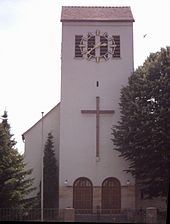
Offenbach belonged before the Reformation to the Archdiocese of Mainz . Count Reinhard von Isenburg introduced the Reformation according to the Lutheran confession after 1542 , but the reformed confession prevailed from 1592 onwards . The city remained a reformed city for many centuries. From 1734 the Lutheran parishioners were again allowed to hold church services. After the transition to the Grand Duchy of Hesse, there was a union between the Reformed and Lutheran congregations to form the Evangelical Church in Hesse . The communities then belonged to the Starkenburg superintendent, based in Darmstadt. Offenbach later became the seat of an independent Propstei Nord-Starkenburg and finally the area became part of the Propstei Rhein-Main within today's Evangelical Church in Hesse and Nassau . Here the ten parishes of the city of Offenbach belonged to the Offenbach deanery until December 31, 2018. On January 1, 2019, the deanery was dissolved, the congregations joined the Evangelical City Deanery Frankfurt am Main , which has since operated as the Evangelical City Deanery Frankfurt am Main and Offenbach .
Roman Catholic parishioners moved back to the city no later than the 18th century. They were allowed to hold church services again from 1798, but did not receive full religious freedom until 1825. Around 1900 the proportion of the city's Catholic population was about 30 percent. This relationship changed at the latest after the incorporation of the predominantly Catholic neighboring communities of Bieber and Bürgel in the 1930s. The parishes of the city belong to the Offenbach deanery within the diocese of Mainz .

The Old Catholic Parish of Offenbach has existed since 1873. At that time, the members of the Offenbach (Old) Catholic Association wrote a "Constitution" in which they solemnly rejected the dogma of the infallibility and the universal jurisdiction of the Pope and at the same time recognized themselves as Catholics, which they wanted to remain true to old beliefs. This constitution, in which the right to form a community, to hold church services and to employ clergy, is the actual founding document of the old Catholic community in Offenbach. Whoever signed this document - the signatures were countersigned and sealed by the mayor's office - was from then on a member of this community. There are many old Offenbach names among the first signatures. In 1874, the grand ducal government in Darmstadt officially established an "old Catholic parish in Offenbach and Bieber with its seat in Offenbach". The old Catholic Christ Church is located between Otto-Steinwachs- Weg and Bismarckstrasse .
The New Apostolic Church is also represented in Offenbach . The community has existed since 1906. In the meantime, there was another community in the Bürgel district, but it was reintegrated into the main community in the city center. The youngest parish in the city is the free evangelical congregation Offenbach. As a free church it belongs to the Federation of Free Protestant Congregations in Germany .
The city mission has existed in Offenbach since 1910 . It was founded through a merger of the Blue Cross work in Offenbach with some Bible circles. Today the Offenbach City Mission offers services for all age groups in addition to church services with childcare. The youth work of the Offenbach City Mission is organized in the EC . As a regional church community , the city mission is a free work within the Protestant regional church, see also Gnadauer Verband .
The orthodoxy is represented in Offenbach: The Greek Orthodox community in the district Tempelsee has many members. Offenbach is the German city with the highest percentage of Greek Orthodox residents.
Judaism
Jews in Offenbach are mentioned for the first time in records from the middle of the 14th century. At the beginning of the 17th century, many Jews who moved to the industrial city in the course of Offenbach's rise were granted admission by the liberal attitude of the Isenburg residents. At the end of the 17th century, more Jews came to live and work in Offenbach. The Offenbach Jews were subordinate to the Oberrabinat Friedberg, church services were held in Bürgel. After special municipal statutes were created in 1706, an independent Jewish community was established in Offenbach a year later . During this time the first synagogue was built as a result of a fire in the prayer room. The Hessian Jews received full civil equality through the grand ducal law of August 2, 1848. From this time on, Jews were significantly involved in the industrial development of the city: the leather goods industry, perfumery, soap equipment, printers with Hebrew letters, bankers, lighting factories, bills of exchange and department stores should be mentioned here.
At the beginning of the 19th century, many Jews settled in Offenbach after fleeing from Eastern Europe. Since Jewish life in Eastern Europe was much longer than traditionally in the West, the so-called "Eastern Jews" made up a considerable number of people who were needed to exercise the Jewish religious service in Germany. In 1910 there were 1,131 mainly Russian Jews living in Offenbach.
At the beginning of the 20th century, the Jewish community in Offenbach was structured completely differently than Frankfurt - "Many members of the community were active, conscious and knowledgeable Jews who took religious liberalism seriously," wrote Mally Dienemann about Offenbach. Her husband Max Dienemann made a circle of friends that included not only Jews but also, for example, the dignitaries of the Christian denominations. He dealt intensively with important contemporary issues in religious life, wrote informative theological and religious-philosophical writings and gave lectures in the large communities in Germany. From 1911 to 1933, Max Goldschmidt, a grandson of the former rabbi Salomon Formstecher, was chairman of the Jewish community in Offenbach . When the National Socialists came to power, community life gradually came to a standstill. After Jewish family fathers were initially deported to concentration camps, their family members were forcibly committed under inhumane conditions to a house in Offenbacher Domstrasse, where the employment office is now located. Most of them were then deported and killed. The synagogue , built in 1916, was devastated during the November pogroms in 1938 and later used as a cinema. In 1939 there were still around 550 Jews living in Offenbach.
After 1945 a small Jewish community was formed again. On July 20, 1945, the congregation was re-established with a total of only twelve members. By 1948 the number of members grew to 86 believers. From 1957 the number rose steadily and in 1986 the community had the largest number of members in the regional association of Jewish communities in Hesse. The new synagogue and the Jewish community center are now opposite the former synagogue and were inaugurated on September 2, 1956 by the then chairman Max Willner .
The collapse of the Soviet Union from 1990 onwards led to a sharp increase in membership to around 1,000 people. In this way the congregation was able to build on the strength that the pre-war congregation with its 1,500 members had until 1938. In 2016, the Offenbach community based in the synagogue had around 800 members. Religious life was sustainably strengthened by the appointment of Mendel Gurewitz from New York in 1998 as the first Offenbach community rabbi after the war. The kindergarten, which was built in the 1950s, is today the only Jewish kindergarten in the state association.
Islam
There are several Muslim communities of different religious or ethnic groups in Offenbach, mainly due to immigrants from Islamic countries. There are seven associations and one community of Alevis with around 4,000 members (as of 2013).
There are fifteen mosques in Offenbach . The Yavuz Selim Mosque was moved into in 1980, making it the city's oldest mosque. The associated congregation has existed since 1977. The El Fath Mosque of the Moroccan Friendship Association offers space for 800 people in the prayer hall, making it the largest mosque in the city.
Other denominations
The free religious community Offenbach am Schillerplatz has existed since 1845 and has around 1,600 members in 2013. It was founded as a German Catholic community by Joseph Pirazzi . Lorenz Diefenbach played a leading role in the early years. The congregation is a member of the Federation of Free Religious Congregations in Germany (BFGD) and through this in the International Association for Religious Freedom (IARF). Since September 2006 she has been running the only free religious kindergarten in Germany.
Politics and administration
As a traditional industrial city, Offenbach am Main was once considered the “red stronghold” of the SPD and KPD. In the Reichstag elections in May 1924 the SPD achieved 32%, the KPD 20.5%, the center 13%, in the Reichstag elections in 1928 (during the boom) KPD 32%, SPD 27%, center 13%, in the Reichstag elections in November 1932 ( in the crisis) SPD 32%, KPD 21%, NSDAP 23%, center 12.5%.
After 1945, a bourgeois coalition of CDU and FDP (with Walter Suermann, CDU, as Lord Mayor and Ferdinand "Ferdi" Walther, FDP, as head of cultural affairs) ruled the city from 1977 to 1985 .
After the coalition of the SPD , Greens and Free Voters, which was victorious in the local elections in 2001 , lost its majority in the 2006 elections, a coalition of SPD, Greens and FDP ruled the city until 2011. After the local elections in 2011, the FDP left the coalition under pressure from the Greens, and since then a majority of the SPD, the Greens and Free Voters have ruled the city council. Although the SPD was just about the strongest force in the 2016 local elections, the CDU, the FDP, the Greens and the Free Voters have formed the coalition that has ruled ever since.
Offenbach belongs to constituency 185 at the federal level , which in addition to Offenbach also includes the cities of Dietzenbach, Dreieich, Egelsbach, Heusenstamm, Langen, Mühlheim, Neu-Isenburg and Obertshausen. Björn Simon (CDU) won the direct mandate in the 2017 federal election . Christine Buchholz (Die Linke) entered the Bundestag via the state list .
The Constituency 43 is the state election district for the city of Offenbach. In the 2018 election, Tarek Al-Wazir (Greens) won the direct mandate with a lead of 1,910 votes. Oliver Stirböck (FDP) entered the state parliament via the state list .
City Council
The city council is the municipal representative of the city of Offenbach am Main. Every five years citizens decide on the allocation of the 71 seats in a general, direct, free, equal and secret ballot. Parties that have at least two city councilors are entitled to form a parliamentary group.
The local elections on March 6, 2016 produced the following results, compared to previous local elections:
| Parties and constituencies | 2016 | 2011 | 2006 | 2001 | ||||||||
|---|---|---|---|---|---|---|---|---|---|---|---|---|
| Share a | Seats | Share a | Seats | Share a | Seats | Share a | Seats | |||||
| Social Democratic Party of Germany | SPD | 24.8 | 18th | 26.3 | 19th | 32.2 | 23 | 39.5 | 28 | |||
| Christian Democratic Union of Germany | CDU | 24.1 | 17th | 30.9 | 22nd | 35.4 | 25th | 32.2 | 23 | |||
| Alliance 90 / The Greens | GREEN | 14.5 | 10 | 22.1 | 16 | 11.0 | 8th | 9.9 | 7th | |||
| Free Democratic Party | FDP | 9.5 | 7th | 5.1 | 3 | 11.0 | 5 | 6.5 | 5 | |||
| Alternative for Germany | AfD | 9.0 | 6th | - | - | - | - | - | - | |||
| The left | LEFT | 7.8 | 6th | 5.5 | 4th | 5.3 | 4th | 2.8 | 2 | |||
| Forum Neues Offenbach | FNO | 2.9 | 2 | 2.0 | 1 | - | - | - | - | |||
| Free voters | FW | 2.7 | 2 | - | - | - | - | - | - | |||
| Pirate Party Germany | Pirates | 1.7 | 1 | 2.3 | 2 | - | - | - | - | |||
| Young Offenbach | JO | 1.3 | 1 | - | - | - | - | - | - | |||
| The Republicans | REP | 1.2 | 1 | 3.4 | 2 | 4.0 | 3 | 5.1 | 4th | |||
| POLITICAL PARTY | POLITICAL PARTY | 0.5 | 0 | - | - | - | - | - | - | |||
| Free voters - FWG | FWG | - | - | 2.5 | 2 | 2.9 | 2 | 3.4 | 2 | |||
| Human Environment Animal Welfare Party | Animal welfare party | - | - | - | - | 1.7 | 1 | - | - | |||
| percentage of invalid votes | 4.9 | 4.5 | 3.4 | 3.6 | ||||||||
| Total seats | 71 | 71 | 71 | 71 | ||||||||
| voter turnout | 32.9% | 33.8% | 31.0% | 40.0% | ||||||||
71 city councilors were to be elected for the legislative period from April 1, 2016 to March 31, 2021. Of the 89,524 eligible voters, 29,484 voted. As a result, voter turnout fell from 33.8% in 2011 to 32.9% in 2016.
| Diagram showing the election results and the distribution of seats | |
|---|---|
Eight groups with at least two city councilors have parliamentary group status after the 2016 election:
- SPD: parliamentary group leader Martin Wilhelm
- CDU: parliamentary group leader Roland Walter
- Greens: Group leader Ursula Richter
- FDP: parliamentary group leader Dominik Schwagereit
- AfD: parliamentary group leader Christin Thüne
- The left: parliamentary group leader Elke Kreiss
- Forum Neues Offenbach: parliamentary group leader Muhsin Senol
- Free voters Offenbach: parliamentary group leader Denis Lehmann
The city councilor of the pirates Grégory Engels works with the CDU parliamentary group.
Offenbach has been ruled by a coalition of CDU, Greens, FDP and free voters since the local elections in 2016.
The magistrate under the directly elected mayor Felix Schwenke forms the “government of the city”. This consists of the Lord Mayor, a full-time first alderman with the official title of mayor, two further full-time aldermen and eight honorary alderman with the official title of city council , who are not only provided by the government coalition.
Mayor and Lord Mayor since 1823
Until 1874 there was only one honorary mayor in Offenbach , from 1887 the mayor was given the title of mayor .
- 1823–1826: Peter Georg d'Orville
- 1826–1834: Heinrich Philipp Schwaner
- 1834–1837: Peter Georg d'Orville (second term of office)
- 1837–1849: Jonas Budden
- 1849–1859: Friedrich August Schäfer
- 1859–1867: Johann Heinrich Dick
- 1867–1874: Johann Martin Hirschmann
- 1874–1882: Hermann Stölting
- 1883–1907: Wilhelm Brink
- 1907–1919: Andreas Dullo (progress)
- 1919–1933: Max Granzin (SPD)
- 1933–1934: Heinrich Schönhals ( NSDAP ), acting
- 1934–1945: Helmuth Schranz (NSDAP)
- 1945–1946: Fritz Reinicke (independent, CDU from 1946), provisional
- 1947–1949: Johannes Rebholz (SPD)
- 1950–1957: Hans Klüber (SPD)
- 1957–1974: Georg Dietrich (SPD)
- 1974–1980: Walter Buckpesch (SPD)
- 1980–1986: Walter Suermann (CDU)
- 1986–1994: Wolfgang Reuter (SPD) (1986–1988 only provisional)
- 1994-2006: Gerhard Grandke (SPD)
- 2006–2018: Horst Schneider (SPD)
- Since January 21, 2018: Felix Schwenke (SPD)
In the direct election for Mayor of the City of Offenbach am Main on September 10, 2017, Felix Schwenke ran against seven other applicants. He got 43.3 percent of the votes in the first ballot in the ballot , which he on 24 September 2017, 67 percent against Peter Freier ( CDU won). The turnout was 30.6 percent in the first ballot and 43 percent in the runoff election. The official business was taken over on January 21, 2018.
Finances
Offenbach is one of the most heavily indebted cities in Hesse. With Darmstadt and Kassel , Offenbach is one of the independent cities in Hesse that is entitled to participate in the municipal protective umbrella of the State of Hesse due to their poor financial situation .
The total amount of public debt of the City of Offenbach at the end of 2012 was 1,405 million euros. Each resident was thus in debt with 12,136 euros. Of the 103 independent cities in Germany, Offenbach was third in terms of per capita debt.
The city of Offenbach has been using the protective screen since February 2013. At the end of 2013, the city had a debt of around one billion euros.
coat of arms
| Blazon : "The city coat of arms shows in blue a silver oak tree with roots and five silver acorns on a blue background." | |
| Reasons for the coat of arms: The oak tree shown symbolizes the old Reichsforst Dreieich , to which the city area belonged. The oak appears in the oldest known seal of the city from 1639. In the 19th century the oak was first placed in a shield. The oak was displayed in natural colors until the beginning of the 20th century and only then in the city colors - these are white-blue. |
Town twinning
The first ties to a town twinning developed in 1952 to the French town of Puteaux in the form of youth and sports encounters. In 1955, this was solemnly consolidated in an official relationship. In 1956, Offenbach and Puteaux were the first cities to receive the European Prize from the European Parliament in Strasbourg. The plaque awarded here can be seen in the city hall.
Today the city is sibling with twelve municipalities (as of November 2015):
|
|
|
|
|
|
|
|
|
|
|
|
|
|
|
|
|
|
City friendship
Offenbach maintains friendly relationships with two cities (as of October 2015):
|
|
|
|
economy
Offenbach's economy was always very broad and never shaped by a few large companies. The immigration of Huguenots and the freedom of trade in the city brought an economic upswing supported by medium-sized companies. Even so, Offenbach had to struggle with a recession as early as the 1970s , as the large electrical and leather goods industries were one of the first to migrate to the Far East. The turning point came with the settlement of service companies, most of which come from the financial and automotive sectors. Former industrial companies often left their administrative headquarters in Offenbach due to the good location. Offenbach has a high density of design offices for graphics and industrial design.
In 2016, Offenbach generated a gross domestic product of € 4.540 billion within its city limits, making it 67th in the ranking of German cities by economic output . In the same year, GDP per capita was € 36,562 per capita (Hesse: € 43,496, Germany € 38,180) and is below the regional and national average. The GDP per labor force is € 68,459, which is significantly higher. In 2017, around 66,300 people were employed in the city. The unemployment rate was 8.9% in December 2018 and thus well above the Hessian average of 4.3%. Offenbach is part of the Rhine-Main metropolitan area, which is one of the most economically powerful regions in the country and has a GDP of more than € 250 billion.
Companies
Industry
From the large number of industrial companies, some larger ones have stayed in Offenbach. Their number has been constant for around ten years and includes Manroland AG , Schramm-Coatings, Alfred Clouth Lackfabrik and Danfoss . The soap factory M. Kappus closed its production site in Offenbach in 2019. Another large Offenbach company with almost 2000 employees is the automotive supplier GKN Driveline , which emerged from the company Löhr & Bromkamp .
Honeywell Germany and Siemens Power Generation have their administrative headquarters in Offenbach . The Groupe SEB to the under other Rowenta heard moved its administrative headquarters in the summer of 2015 away from Offenbach, following her 2016 Areva.
After its merger with Chemische Fabriken Griesheim-Elektron as the Offenbach plant, the former Oehler tar paint plant in Offenbach was for a long time an important location for Hoechst AG for the production of dyes and polyester intermediates . After 1997 and several changing owners, all production facilities were completely dismantled in 2010.
The once important leather goods manufacture hardly plays a role today, the former industry leader Goldpfeil also closed in 2008, but manufacturing companies and sales companies can still be found in the Offenbach area in large numbers.
The power supply Offenbach now belongs to the Mannheimer MVV Energie AG. It supplies over 160,000 customers and operates, among other things, a waste-to-energy plant , in which more than 200,000 tons of waste are incinerated annually.
Services
Offenbach's city center is closer to Frankfurt than many parts of the neighboring city. In the western district of Kaiserlei in particular, banks, insurance companies and management consultancies with administrative offices or departments, such as BHF-Bank and Capgemini , settled after the construction of the S-Bahn .
With 3,000 companies, Offenbach is one of the most important design clusters in Germany. The companies range from architecture to typography, graphic and web design, industrial and vehicle design as well as film and animation. The reasons for this are on the one hand the history as a historical production site and the university of design , on the other hand also the central location in the Rhine-Main area. In addition, the city promotes the settlement of relevant industries.
Automobile manufacturer
In the automotive sector, Offenbach am Main is part of the so-called automotive cluster Rhein-Main , which covers the entire value chain from production sites (Opel, Continental, Lear etc.) to development sites and European headquarters. The “Honda R&D Europe” development and design department of the automobile manufacturer Honda is located in the Bieber-Waldhof industrial park . This is where the pioneering Honda Small Hybrid Concept (2007) model was developed. The European headquarters of the Korean automobile manufacturer Hyundai and the administration of the Korean tire manufacturer Kumho Tire are also located in Offenbach's Kaiserlei district . The European headquarters of the Japanese tire brand Falken is located in Offenbach's City Tower.
retail trade
Offenbach's shopping streets are Frankfurter Strasse and Grosse Marktstrasse, which run parallel to each other. A few hundred meters to the east is Wilhelmsplatz with delicatessen shops. The Offenbach weekly market also takes place there. The market square, on the other hand, is a street in the city center, after which the S-Bahn station is named.
In September 2009 the KOMM shopping center (22,000 m³ area) opened on Aliceplatz with 60 shops on three floors. On the southern arterial roads Waldstrasse and Sprendlinger Landstrasse (as well as the Odenwaldring connecting them) there are mainly branch stores such as supermarkets and car dealerships, as well as the ring center .
Government and healthcare
In contrast to Wiesbaden or Darmstadt, for example, no public research institutions, large federal agencies or companies with state participation were established in Offenbach. After the federal monopoly administration for spirits was wound up at the end of 2018, only the German Weather Service remained in Offenbach as the higher federal authority.
In the building of the former barracks on Bieberer Straße , the main administration of the railways of the American and British occupation areas had its seat from 1947. In September 1949 the German Federal Railroad was founded, which moved its headquarters to Frankfurt am Main in October 1953.
Offenbach has several clinics. The Sana Klinikum Offenbach - formerly Klinikum Offenbach - with 891 fully inpatient and 35 partially inpatient beds is a maximum care hospital . It functions as the academic teaching hospital of the Johann Wolfgang Goethe University in Frankfurt , is known nationwide and provides medical care for the population of the city as well as the Offenbach district. At the end of 2009, the clinic received a new building for around 140 million euros. The Ketteler Hospital with 270 beds is a standard care hospital. The Frühauf Clinic with 36 beds is a homeopathic hospital as well as a private internal clinic. The AOK has its district administration in Offenbach.
In addition to the Southeast Hesse police headquarters on Parkstrasse, Offenbach also has two police stations that are responsible for the western and eastern parts of Offenbach.
The Offenbach fire department consists of a professional fire department , three volunteer fire departments and a youth fire department .
German Weather Service
The German Weather Service with its headquarters in Offenbach provides an indispensable service for the Rhine-Main area with around 90,000 forecasts per year and around 30,000 weather and severe weather warnings annually (as of 2014). The German Weather Service plays an important role in aviation at Frankfurt Airport .
Monitoring and researching climate change is also important in order to be able to assess the effects of global warming and its consequences and to minimize potential damage at national and international level. With the German Meteorological Library , the DWD has one of the largest specialist libraries in the world.
The German Weather Service operates a weather park that is freely accessible to visitors.
Infrastructure
Road traffic
The most important inner-city main streets are Kaiserstraße , Frankfurter Straße, Berliner Straße, Mainstraße, Waldstraße and the southern Ringstraße consisting of Taunus-, Odenwald-, Spessartring and Rhönstraße. Important arterial roads are the Sprendlinger Landstraße (to the southwest), the Bieberer Straße (to the southeast) and the Mühlheimer Straße (to the northeast).
The Carl-Ulrich-Brücke connects the Kaiserstraße with Fechenheim, the Main ferry Rumpenheim connects the Offenbach district of Rumpenheim with the Maintaler district of Bischofsheim .
In the south of the city, the federal highway 3 passes, which meets the federal highway 661 in the west of the city at Offenbacher Kreuz . The federal highways 43 , 46 and 448 also run through the city.
Since January 1, 2015, the entire urban area has been an environmental zone .
Rail transport and local public transport
The Bebraer Bahn railway line runs through Offenbach, and has been in the inner city area since 1910 as an elevated route based on the Berlin model. This is also where Offenbach Central Station , built between 1872 and 1873, is located, which has largely lost its importance for long-distance traffic. Only one IC connection from Deutsche Bahn stops in Offenbach every day (as of April 2016).
Rail-bound transport Offenbach is of regional trains of Deutsche Bahn and the vias GmbH ( Odenwaldbahn ) and the lines S1, S2, S8 and S9 of the train Rhein-Main operated. Since the end of the operation of individual journeys of the S2 starting or ending at the main station during rush hour, all S-Bahn traffic in the city center has taken place on a specially built tunnel route (which follows the course of the former local railway line). In Offenbach there is therefore the curious situation that S-Bahn traffic is completely separate from regional and long-distance traffic, the main station has no S-Bahn connection and consequently there is no direct transfer from regional and long-distance to S-Bahn traffic.
Train stations
There are seven train stations and stops in Offenbach am Main, one of which is a regional train station and six other pure S-Bahn stations. The stations are on the Frankfurt – Göttingen railway line , in the Offenbach City Tunnel and on the Rodgau Railway .
- Offenbach train stations and stops
| Surname | district | Operating office | |
|---|---|---|---|
| Offenbach-Bieber | Beaver | railway station | |
| Offenbach Central Station | Center , Senefelderquartier | railway station | |
| Offenbach-Kaiserlei | Kaiserlei | railway station | |
| Offenbach Leather Museum | Northrend | railway station | |
| Offenbach market square | center | railway station | |
| Offenbach East | Offenbach-East | railway station | |
| Offenbach-Waldhof | Beaver | Breakpoint |
buses
Regional buses operated by Regionalverkehr Kurhessen GmbH (RKH) and city buses operated by Offenbacher Verkehrsbetriebe GmbH (OVB) operate in Offenbach . A few bus lines operated by Verkehrsgesellschaft Frankfurt am Main mbH (VGF) from Frankfurt also end there. There is a local transport organization (LNO). It bundles city traffic under the umbrella brand “Nahverkehr in Offenbach” (NiO).
All rail and bus lines in the city are to be used at uniform prices within the Rhein-Main-Verkehrsverbund (RMV).
From 1951 to 1972 the Offenbach trolleybus operated in the city. Today's local transport in Offenbach am Main is still operated exclusively with diesel buses , but from 2019 the buses are to be replaced by electric buses for new acquisitions. In 2011, Offenbach was the first city in Germany to test an electric bus over a period of several weeks.
tram
One of the world's first electric trams operated in Offenbach am Main .
The route of the Frankfurt-Offenbacher Trambahn-Gesellschaft (FOTG) opened in 1884 at the endeavors of an Offenbach consortium consisting of the Kommerzienrat Weintraut, the banker Weymann and the Bankhaus Merzbach, led from the Old Bridge in Sachsenhausen, Oberrad to Offenbach via Frankfurter Straße to Offenbach market square and on to Mathildenplatz. From 1906 Offenbach had a city tram with three lines.
In 1967 the last inner-city line was shut down, afterwards only line 16, operated by the Frankfurt tram, ran through the city to the market square. In 1996 the decision was made to ban the tram from the city, which has since ended at the city limits of Frankfurt. All systems were dismantled. Passengers have to change to buses there. Again and again burgeoning discussions about a reconstruction of the route or an extension of the tram from Frankfurt-Fechenheim are sat out by the city.
Bike rental
In cooperation between the municipal company Nahverkehr in Offenbach am Main (short: NiO) and the city, a bike rental system with initially 50 bikes was installed in March 2008 . The operator of the public bike rental system was Nextbike . Since summer 2016, Deutsche Bahn Connect has operated the service under the name Call a Bike with a total of 78 rental bikes.
The total of 13 rental stations can be found at the S-Bahn stations, in the city center and in Bieber, Bürgel, Rumpenheim and Tempelsee.
Long-distance cycle routes
Several cycle paths run along the banks of the Main :
- the Hessian long -distance cycle route R3 ( Rhein-Main-Kinzig-Radweg ) leads under the motto In the footsteps of the late harvest rider along the Rhine , Main and Kinzig via Fulda to Tann in the Rhön
- The Main Cycle Path leads from the sources of the White and Red Main via their confluence at Kulmbach to Mainz where it flows into the Rhine (almost 600 km)
- the D-Route 5 (Saar-Mosel-Main) from Saarbrücken via Trier, Koblenz, Mainz, Frankfurt am Main, Würzburg and Bayreuth to the Czech border (1,021 km)
- the EuroVelo route EV4 from Roscoff in France to Kiev in the Ukraine (4,000 km).
Freight transport and inland waterway transport
In the period from 1873 to 1919, the freight yard was right next to Offenbach's main station (passenger station). In 1919 the new and still operated Offenbach freight yard in the east of the city went into operation.
In inland shipping , Offenbach is connected to the important industrial regions in North Rhine-Westphalia and the Netherlands via the Main and the Rhine, and to south-eastern Central Europe via the Main-Danube Canal .
The Offenbach harbor , however, is only of marginal importance; large parts of the terrain are now fallow. A new district for living and working has been under construction on the Hafeninsel since 2012. The berth on the banks of the Main near Isenburg Castle is popular with inland waterwaymen, as it is close to the city center.
The Offenbach barrage at kilometer 38.51 of the Main is a barrage with a lock. It is located on the city limits of Frankfurt in the Offenbach-Kaiserlei district .
Culture and sights
Cultural history
A cultural exchange also arose in the context of the Offenbach manufactories. Paganini visited the Pirastro company, which was known for their strings, and Mozart visited the music publisher André , which published his sheet music. Goethe cultivated love affairs in the then distant suburb of Frankfurt. The Wilhelm Gerstung printing company hired well-known graphic artists. The arts and crafts school and the Klingspor type foundry brought their own cultural impulses, for example with the typographer Rudolf Koch and later with Karlgeorg Hoefer . In 1926 the "Bund Offenbacher Künstler" was founded, u. a. by Adolf Bode , Erich Martin , Oswald Ammersbach, Paul Arnoul, Karl Appel, Wilhelm Gast, August Ziegler, Karl Huber, Richard Throll and Otto Reichert. The city offered artists inexpensive studios from its own inventory, so that the colony of "Bach street painters" soon emerged. Dominikus Böhm's church building school set standards in architecture .
During the Nazi era, part of the local art scene was absorbed by the new rulers, so Hitler bought two sculptures by the Offenbach sculptor Richard Martin Werner , and the university was awarded for an artistic edition of Mein Kampf and a map of Germany. Some of the painters went into resistance, such as Ludwig Plauen, who went into hiding. Jewish patrons of cultural life such as Robert von Hirsch and Siegfried Guggenheim emigrated. After 1945, the city fought to maintain or re-expand the art college, which had been degraded to a craft school during the Nazi era, but ultimately had to resign the architecture faculty after a few deadlines. The architect Hugo Eberhardt and the painter Karl Friedrich Lippmann died in the 1950s . The reconstruction was led by the city planning officer Adolf Bayer . For a long time Offenbach stood for traditional design compared to Frankfurt, but since the 1950s at the latest, differences have leveled out due to the proximity, so that you can no longer draw borders and see the city in the context of Frankfurt. For example, the architects Paul Friedrich Posenenske , Ernst Balser and later Novotny Mähner Associate were active in both cities, and both cities had an important jazz scene in the 1970s. From 1953 to 1963 there was the graphic design office Michel + Kieser , which was known for postage stamp designs for the Federal Post Office and posters.

The Capitol , formerly the synagogue , the adjacent trade fair and the city hall are the most important venues. Many events take place in the vicinity of the Hochschule für Gestaltung, ranging from small vernissages - for example in the bicycle hall or in the wagon - to large events such as the Crossmedianight and the Festival of Young Talents . The Neue Philharmonie Frankfurt has had the Capitol as its domicile since 2005.
The Night of the Museums is organized together with Frankfurt. The annual Mainuferfest also takes place along the Main between Büsing-Palais and Isenburg Castle.
theatre
In Offenbach there are several small stages for variety and cabaret as well as several event halls such as the Capitol, the city hall or the so-called Leather Palace in the Leather Museum, in which theater performances also take place. The theater club ELMAR , which was founded in 1911 and from which Kai Frederic Schrickel ( city clinic ) also emerged , has a tradition in Offenbach's theater landscape .
Cinemas
The once rich cinema landscape with small cinemas came to an end at the end of the 1990s: after the Universum , the Broadway cinema on Kaiserstraße closed in 1998 and after the opening of a multiplex cinema on Berliner Straße, the Gloria-Kino-Center closed in 1999 .
In addition, there are regular screenings in an open-air cinema in the Hafen 2 cultural center during the summer months and in its event hall during the rest of the time. There is an expanded cinema in the Leather Museum, which was at times the communal cinema in the 1980s. Since 2011, the hall will be named Leather Palace as cinema used by the club and cinema in the DLM operated. The association also uses the old locksmith's shop of Energieversorgung Offenbach for cinema screenings.
Museums
The German Leather Museum was founded by the architect and professor of the technical institutes Hugo Eberhardt and since then has turned from applied art more to ethnology, leather goods are also shown (also as devotional objects of personalities).
The Klingspor Museum emerged from the company collection of Karl Klingspor and the collection of Siegfried Guggenheim . Rare book editions with a typographical claim are from that period, including the bequests of Rudolf Koch (the developer of the Offenbach font ), Otto Reichert, Heinrich Jost as well as the Manuale Tipografico by Bodoni and works by Peter Behrens . A focus of the last few decades has been on handicraft-decorative books and the painting of letters.
The Haus der Stadtgeschichte , which emerged from the city museum and the city archive, shows the historical development of the city of Offenbach. The focus is on the Offenbach factories , the Huguenots and the printing industry. The Bieber amulet is also exhibited here; Current art is shown in the museum's industrial hall. In April 2011 a new Department of Modern Art / Graphic Collection was opened with an exhibition on Erich Martin .
Since March 7, 2007, the fourth division soccer team Kickers Offenbach has had the fan- operated Kickers Fan Museum . Since June 2011 it has been based in Offenbach-Bieber. The museum is financed by a total of 500 sponsors. There are fan articles on display that have been collected by the operators over the past 25 years.
The Talberg Museum (TAMU for short) was opened in June 2011. In addition to works by Ruben Talberg , works of contemporary Israeli art can be seen in special exhibitions.
The Digital Retro Park Museum for digital culture has existed since 2018 .
Regular events
- February / March: Carnival (see also: Carnival in the Rhine-Main area )
- March and September: International Leather Goods Fair
- March / April: Luminale (every two years)
- April 30th: Dance into May (on Wilhelmsplatz )
- End of April / beginning of May: art views (every two years, alternates with the Festival of Young Talents )
- End of April / beginning of May: Long Night of the Museums (together with Frankfurt)
- May: Offenbach City Run
- End of May / beginning of June: Offenbach Week
- June: Mainuferfest
- June: Dragon boat race
- July: Tour of the Offenbach am Main University of Design
- July: Cross Media Night - film night at the HfG Offenbach
- August: Festival of Lights in Büsing Park
- August: Beer festival around the town hall (last event 2016, 2017 canceled)
- First weekend in September: Children's party in the Leonhard-Eißnert-Park
- September: Festival of young talents (every two years, alternates with the art views)
- September: Jazz matinee in the Büsing-Palais
- November / December: Christmas market
Culinary specialties
Offenbach has been world famous for its pepper nuts since the 18th century . The city was mentioned in encyclopedias, trade fair catalogs, diaries and magazines in connection with the pastries. The state of Hesse had it served as a Hessian specialty at state receptions until 1980. From the 1980s onwards, pepper nuts were temporarily forgotten. The pastry is a light and soft cookie that contains spices such as pepper, nutmeg, coriander and cinnamon. Allegedly the Offenbach confectioner Philipp Fleischmann created the recipe in 1757. Even Goethe already liked the pastries. This has been available again since 2014.
In the West , the mineral water was from 1888 to 1996 Kaiser-Friedrich-source and the lemonade Frischa bottled. A special feature was the high iodide content of which 1 liter covered the daily iodide requirement of an adult, and the iron content was not removed from the spring water.
education
Offenbach am Main does not have a university , but with the Hochschule für Gestaltung it is a state art college. It was founded in 1832 as a crafts school / technical training institute and gained university status in 1970, until 1982 there was also an architecture department. Today there are still two departments: art (with the four disciplines communication design, media, art and stage design) and design (product design).
The city of Offenbach has a wide range of schools:
|
13 primary schools:
|
four high schools:
three comprehensive schools:
two primary, secondary and secondary schools with special needs schools:
a secondary school with a special school:
|
four private schools:
three special needs schools:
four vocational schools:
|
Offenbach has also been a VWA location (Administration and Business Academy) since 2006 . At the Offenbach Clinic, the VWA Offenbach primarily offers business administration courses for employed people.
The Katholisches Bildungswerk Südhessen is responsible for the Catholic adult education in the Diocesan Education Center Mainz in the deaneries Dreieich, Offenbach-Stadt, Rodgau, Rüsselsheim and Seligenstadt.
Sports
The largest football club in Offenbach is Kickers Offenbach ( OFC for short ). The fourth division plays its home games in the Sparda Bank Hessen Stadium with around 20,500 seats. This was completely rebuilt with public funds in place of the stadium on Bieberer Berg and put into operation in June 2012. The club was in the first division more often, was in the final of the German soccer championship in 1950 and 1959 and was runner-up in each case, and in 1970 the club won the DFB Cup . Most recently, the club faced bankruptcy in 2013 and 2016.
The forest swimming pool on the Rosenhöhe is the location of the First Offenbach Swimming Club ( EOSC for short ). The swimming pool is freely accessible all year round. The club's most famous swimmer is Michael Groß .
The fencing club Offenbach from 1863 e. V. is the second oldest fencing club in Germany. The club's best-known female fencers are Helene Mayer and Cornelia Hanisch .
There are also rowing clubs and tennis clubs in Offenbach. The Hessian Tennis Association is based in Offenbach.
Unusual for a city the size of Offenbach is the lack of permanent ice skating facilities. However, there were always plans for a multifunctional hall with ice rink at the Kaiserlei, together with the city of Frankfurt, which should also be used for ice hockey games . Implementation is still pending. Until the 1930s there was a permanent ice rink on Tennisstrasse.
media
The Offenbach -Post daily is published in Offenbach am Main . The regional community television broadcaster Offener Kanal Offenbach-Frankfurt broadcasts from Offenbach into the cable network . The Frankfurter Rundschau has had a local office on Kaiserstraße since 2010. respekt OF is an Offenbach magazine about culture and business that is only sold through bookstores, of: rot is a free Offenbach magazine about culture and events.
useful information
Rivalry between Offenbach and Frankfurt
As between many neighboring cities, there has always been a good neighborly rivalry between Frankfurt and Offenbach am Main, which is expressed, among other things, in numerous jokes about the residents of the other city. At Offenbacher Stadthof on the corner of Frankfurter Straße , an episode of this rivalry is manifested in a group of sculptures made of bronze: “ Get sick, Offebach ! Die Staa binne se, the dogs let se laafe! ”The background is the exclamation of a Frankfurt merchant who visited Offenbach in winter in the 19th century and was attacked by dogs running free. However, the stone he stooped to fend off the dogs was frozen to the ground. The merchant was, of course, served and wished Offenbach the disease.
The rivalry between the two cities is historically anchored. Territorial conflicts between the imperial city of Frankfurt and its neighboring states had existed since the Middle Ages. During the Thirty Years' War, the Swedish King Gustav Adolf took quarters in Isenburg Castle in Offenbach. From there he demanded the surrender of Frankfurt. After the Reformation , Lutheran Frankfurt and Reformed Offenbach were involved in denominational disputes. Since the 18th century, the Counts of Isenburg also encouraged the settlement of manufacturers that were not wanted in bourgeois Frankfurt. Even in the 19th century, Frankfurt saw itself as a pure trading city, which continued to lead to industrial relocation to Offenbach. Only after the annexation by Prussia did Frankfurt follow suit with industrialization and soon surpassed its rivals. In the 20th century, Frankfurt grew mainly through the incorporation of Prussian suburbs to the north and west, while Offenbach had no expansion opportunities. Until 1945, the border between the two neighboring cities also always formed a state border.
The two football clubs Kickers Offenbach and Eintracht Frankfurt and their respective supporters have had a longstanding sporting rivalry . Over the years, the two teams often faced each other in a mainderby , particularly often in the 1950s (for example in the final of the German soccer championship in 1959), in the DFB Cup (most recently in 2009 ) and in the Bundesliga until the relegation of the Kickers 1984.
Sophie von La Roche Prize
Since 2010, the city of Offenbach am Main has been awarding the "Sophie von La Roche Prize for Equal Rights for Women" every two years. The prize, endowed with 1,500 euros, honors special commitment and excellent performance in the cultural, social or societal field.
Originals
Matchstickcarps
The match seller Karl Winterkorn (born March 28, 1880 in Zell am Main ; † February 12, 1939 in Offenbach) is considered the Offenbach original .
At the beginning of the 20th century, he roamed the Offenbach and Frankfurt cider bars and sold matches . He achieved local fame for his small height of only 1.30 meters and his plump figure. But he was best known for one of his sayings. When asked what his job was, he replied: Timber dealer .
He lived on Gerberstrasse (today Arthur-Zitscher-Strasse 4). In his honor there is a statue made by the master stone sculptor Judith Quartier and inaugurated in April 2000 on Wilhelmsplatz in Offenbach. His grave in the old cemetery is tended by strangers.
Maabär
Franz Georg Weber (born May 21, 1867 in Gießen ; † October 13, 1935 in Offenbach am Main) was an Offenbach city original known under the name Maabär . He lived on the Main during the warm time of the year and often slept under the Main bridges. He earned his living doing auxiliary work for rowers, raftsmen and river boatmen. He was known and loved for his grumpy and at the same time honest manner. According to his own admission, he personally saved several people from drowning, although the city was well known that he could not swim.
Personalities
literature
- Magistrate of the city of Offenbach, Wolfgang Armin Nagel (Hrsg.): Offenbach am Main - young German city . Hanau, Huwe-Verlag:
1st edition 1954, 170 pages, 257 illustrations, 120 photos, DNB 453637302 ;
2., completely changed new edition 1959, 194 pages, DNB 453637310 ;
3rd, completely changed edition 1962, 166 pp., 131 ills ., 67 photos, DNB 453637329 ;
4th, completely changed edition 1966, 175 p., 153 illustrations, 57 photos, DNB 457731478 . - A well-illustrated insight into the official presentation of the structure and change in the 1950s / 60s - Hessian town book; Volume IV 1st sub-volume from “German City Book. Handbook of urban history “- On behalf of the working group of historical commissions and with the support of the German Association of Cities, the German Association of Cities and the German Association of Municipalities, ed. by Erich Keyser, Stuttgart 1957, DNB 454817037 .
- Günter Burkhard: The Attractors of Poverty - A socio-ecological study of the residential distribution of poverty in the city of Offenbach. Shaker Verlag , Aachen 1998, ISBN 3-8265-2696-1 .
- Alfred Kurt: History of the city and district of Offenbach - on the Main, in Rodgau and in the Dreieich. Bintz-Verlag, Offenbach 1998, ISBN 3-87079-009-1 .
- Hans Georg Ruppel, Lothar Braun: It all started in Offenbach ... Offenbach City Administration , Offenbach 2004, ISBN 3-9801846-3-3 .
- Hans Georg Ruppel: History of the city of Offenbach. New edition, Wartberg Verlag, Gudensberg-Gleichen 2003, ISBN 3-8313-1334-2 .
- Ulrich Jung: That was the 20th century in Offenbach and the region. Wartberg Verlag, Gudensberg-Gleichen 2003, ISBN 3-86134-923-X .
- Wilfried B. Sahm, Christina Uslular-Thiele: Offenbach - what a city. Ed .: Volkshochschule Offenbach, Cocon-Verlag, Hanau 2004, ISBN 3-937774-05-X .
- Helmut Hill (ed.): Rumpenheim and Waldheim, lively districts of Offenbach am Main. CoCon-Verlag, Hanau 2006, ISBN 3-937774-25-4 .
Movie
- Picture book Germany - Offenbach am Main. Documentary, Germany 1999, 43:40 min., Script and director: Heidi Lange, production: Hessischer Rundfunk , series: Bilderbuch Deutschland, first broadcast: 2000.
- Out and about in Offenbach. Documentary, Germany 2014, 44:43 min., Production: Hessischer Rundfunk , series: Stories from Hessen, first broadcast: 2014.
- Out and about in Offenbach. Documentary, Germany 2016, 29:16 min., Production: Hessischer Rundfunk , series: Herrliches Hessen, first broadcast in 2016.
Web links
|
Further content in the sister projects of Wikipedia:
|
||
|
|
Commons | - multimedia content |
|
|
Wiktionary | - Dictionary entries |
|
|
Wikisource | - Sources and full texts |
|
|
Wikinews | - News |
|
|
Wikivoyage | - Travel Guide |
- Link catalog on Offenbach am Main at curlie.org (formerly DMOZ )
- Official website of the city of Offenbach am Main
- Association Wiki: Associations in Offenbach am Main
- Literature from and about Offenbach am Main in the catalog of the German National Library
Individual evidence
- ↑ Hessian State Statistical Office: Population status on December 31, 2019 (districts and urban districts as well as municipalities, population figures based on the 2011 census) ( help ).
- ↑ Johann Geiß: On the trail of the prehistory. In: Offenbacher Geschichtsverein: Offenbacher Geschichtsblätter. No. 32, 1982, ISSN 0471-122X , p. 67 ff.
- ↑ Compare among other things: Wilhelm Müller: Hessisches Ortnamesbuch . tape 1 : Starkenburg. Darmstadt 1937, DNB 720298903 .
- ^ Alfred Kurt: A thousand years Offenbach 977 - 1977. In: Offenbacher Geschichtsverein: Offenbacher Geschichtsblätter. No. 26, 1977, p. 11.
- ↑ Otto Volger : The meaning of the name of the city of Offenbach. In: Volumes 1 - 9th report of the Offenbacher Verein für Naturkunde . 1860–1868, Offenbach am Main. Full text / preview in Google Book Search.
- ↑ Offenbach am Main - portrait in numbers. (PDF; 388 kB) (No longer available online.) In: offenbach.de. City of Offenbach am Main, Public Relations Office, 2012, archived from the original on September 24, 2015 ; Retrieved May 29, 2016 .
- ↑ Proposal from the Magistrate's submission no. From: pio.offenbach.de , May 6, 2010, accessed October 6, 2015.
- ↑ a b Statute for the definition and naming of the districts in the area of the city of Offenbach am Main. In: offenbach.de. July 15, 2019, accessed August 20, 2019.
- ↑ A district with a long history: Bürgel. From: offenbach.de , accessed on October 6, 2015.
- ↑ Bieber's landmark is 3000 years old. From: offenbach.de , accessed on October 6, 2015.
- ↑ Anton Jakob Weinberger: Lush land against a tram. In: faz.net. March 31, 2008, accessed October 6, 2015 .
- ↑ a b Residents of the city of Offenbach am Main by statistical districts on December 31, 2015 (PDF; 36 kB) City of Offenbach am Main, December 31, 2015, accessed on April 27, 2016 .
- ↑ Hessen-Forst: Final report on forest management planning Stadtwald Offenbach. Status: January 1, 2017, p. 2. Online.
- ↑ Hessen-Forst: Final report on forest management planning Stadtwald Offenbach. Status: January 1, 2017, p. 5. Online.
- ↑ Airplane bombs depress the proceeds . In: Offenbach-Post . August 6, 2009.
- ^ A b Karl Nahrgang: The archaeological finds of prehistory and early history in the city and district of Offenbach am Main . Waldemar Kramer Verlag, Frankfurt 1967, DNB 456145052 , p. 149 .
- ^ Archaeological finds in Offenbach am Main. ( Memento from May 15, 2011 in the Internet Archive ). The map gives the localities only approximately in order to avoid damage by self-declared but inexperienced archaeologists. PDF, 45 kB.
- ↑ Johann Friedrich Böhmer , Hanns Leo Mikoletzky : The Regest of the Empire under Otto II. 955 (973) -983 . In: Regesta imperii 2, Department 2 . Böhlau Verlag, Graz 1950, DNB 366868497 , p. 74 ( online ).
- ^ Uta Löwenstein: County Hanau . In: 'Ritter, Grafen und Fürsten - secular dominions in the Hessian area approx. 900 - 1806 = Handbook of Hessian History 3 = Publications of the Historical Commission for Hesse 63. Marburg 2014. ISBN 978-3-942225-17-5 , p. 196-230, p. 207.
- ↑ Lothar R. Braun: How Offenbach would have almost become Bavarian. In: op-online.de. January 18, 2014, accessed July 1, 2015 .
- ↑ Angelika Ohliger: Offenbach's telephone pioneers. In: fr-online.de. July 14, 2011, accessed January 14, 2015 .
- ↑ Martin Kuhn: excavators seal the end. In: op-online.de. August 9, 2009, accessed July 1, 2015 .
- ↑ Offenbach: Like a tomb for the murdered great-grandfather. In: faz.net. February 26, 2006, accessed October 6, 2015 .
- ^ Anton Jakob Weinberger: The image of the industrial city corrected. In: faz.net. February 28, 2008, accessed July 1, 2015 .
- ↑ Renovation of the Marienkirche (1999–2001). From: bistummainz.de , accessed on November 4, 2013.
- ↑ State Office for the Preservation of Monuments Hesse (ed.): Town Hall In: DenkXweb, online edition of cultural monuments in Hesse .
- ↑ Daniel Bartetzko: “Completely wacky complex”. INTERVIEW: With Peter Cachola Schmal in Offenbach. . In: ModerneREGIONAL 2014, Edition 2, accessed on October 7, 2015.
- ↑ Fact sheet on the development work in the first phase of the Offenbach port project. (PDF; 31 kB) In: offenbach.de. Mainviertel Offenbach GmbH, March 2009, archived from the original on March 4, 2016 ; accessed on August 1, 2016 .
- ↑ The construction fields in Offenbach harbor. ( Memento from January 26, 2016 in the Internet Archive ) On: offenbach.de , accessed on October 7, 2015 (PDF; 1.5 MB).
- ↑ Quarters. From: offenbach.de , accessed on October 7, 2015.
- ↑ Matthias Dahmer: First new building since 1978: Port School in Offenbach is officially opened with a celebration and words of praise. In: op-online.de. August 31, 2017, accessed September 7, 2017 .
- ↑ For the waters as a whole, see the waters in Offenbach. ( Memento of July 3, 2015 in the Internet Archive ) On: offenbach.de , July 2011, accessed on October 7, 2015 (PDF; 1.9 MB).
- ↑ 60 years ago: Offenbach becomes a big city. In: op-online.de. August 18, 2014, accessed September 21, 2015 .
- ↑ Simon: Offenbach is the largest integration machine. In: op-online.de. April 10, 2009, accessed September 23, 2015 .
- ↑ Matthias Schulze-Böing in an interview with Kai Vöckler: Offenbach as a good example at the Venice Architecture Biennale. ( Memento from August 24, 2016 in the Internet Archive ) In: offenbach.de , accessed on August 24, 2016.
- ↑ Residents with a migration background on December 31, 2016 (main residence). (PDF; 49 kB) (No longer available online.) City of Offenbach am Main, archived from the original on January 17, 2018 ; accessed on January 17, 2018 .
- ↑ Michael Rasch: In German cities, the majority society is facing its end | NZZ . In: Neue Zürcher Zeitung . July 9, 2019 ( nzz.ch [accessed July 23, 2019]).
- ↑ Figure 2: Mainly religious affiliation in the Hessian communities in 2011 Source: Hessisches Statistisches Landesamt , accessed on August 27, 2020
- ↑ City of Offenbach Denomination as of June 30, 2020 , accessed on August 27, 2020
- ↑ Denominations 2001 2018. (PDF; 34 kB) In: offenbach.de. December 31, 2018, p. 1 , accessed June 12, 2019 .
- ↑ City of Offenbach am Main Religion -in%, 2011 census
- ↑ About us. From: stadtmission-offenbach.de , accessed on February 10, 2015.
- ↑ a b c d e About us. The history of Offenbach Jews. From: jgof.de , accessed on November 28, 2015.
- ↑ János Erkens: The History of the Synagogue. In: fr-online.de . April 10, 2016, accessed August 24, 2016 .
- ↑ Places of Faith. Municipality of Offenbach, S. 7.: offenbach.de , November 7, 2013, accessed June 18, 2015. (PDF, 3.1 MB).
- ↑ Attacks in the back of your mind. In: Offenbach-Post. April 6, 2019, p. 16.
- ↑ Places of Faith. Municipality of Offenbach, page 17. On: offenbach.de , November 7, 2013, accessed June 18, 2015. (PDF, 3.1 MB).
- ↑ Places of Faith. Municipality of Offenbach 36. On: offenbach.de , November 7, 2013, accessed June 18, 2015. (PDF, 3.1 MB).
- ↑ Basic information about the free religious community Offenbach. ( Memento from February 2, 2014 in the Internet Archive ) On: freireligioese-offenbach.de , accessed on February 10, 2015.
- ^ Elections in the Weimar Republic. From: gonschior.de, accessed on January 21, 2014.
- ^ Matthias Dahmer: "Tanzania" coalition sealed in Offenbach. In: op-online.de. May 25, 2016. Retrieved February 19, 2018 .
- ↑ 2017 Bundestag election. Retrieved September 26, 2017 .
- ↑ hessenschau.de, Frankfurt, Germany: These are the 50 Hessian members of the Bundestag | hessenschau.de | Politics . In: hessenschau.de . September 25, 2017 ( hessenschau.de [accessed September 26, 2017]).
- ↑ State election 2013 in Hesse: Tarek Al-Wazir. ( Memento from February 19, 2014 in the Internet Archive ) On: statistik-hessen.de accessed on January 21, 2014.
- ↑ Information on the state election. Retrieved August 14, 2019 .
- ↑ Oliver Stirböck | Hessian state parliament. Retrieved August 14, 2019 .
- ^ Result of the municipal election on March 6, 2016. Hessian State Statistical Office, accessed in April 2016 . .
- ↑ Hessian State Statistical Office: Results of the municipal elections of 2011 and 2006.
- ↑ Hessian Statistical Office: Results of the municipal elections of 2001 and 1997.
- ^ Until 2001: Party of Democratic Socialism (PDS).
- ↑ Parliament & political groups. In: offenbach.de , accessed on June 10, 2016.
- ↑ political groups. Retrieved December 27, 2017 .
- ^ FDP Offenbach: parliamentary group. Retrieved April 25, 2019 .
- ↑ Martin Kuhn: Pirate Gregory Engels now part of the CDU parliamentary group in Offenbach. In: op-online.de. March 29, 2016, accessed June 10, 2016 .
- ^ Matthias Dahmer: Tanzania coalition sealed in Offenbach. In: op-online.de. May 25, 2016. Retrieved June 10, 2016 .
- ↑ Martin Kuhn: The way is free for the magistrate of four. In: op-online.de. May 14, 2016, accessed June 10, 2016 .
- ↑ a b Electoral Office of the City of Offenbach am Main: OB election: Final result. In: offenbach.de. September 11, 2017. Retrieved September 13, 2017 .
- ↑ Pan and suitors have to go to the runoff election. In: FAZ.net . September 11, 2017. Retrieved September 15, 2017 .
- ↑ Run- off election Mayor 2017. In: offenbach.de. Retrieved September 24, 2017, September 24, 2017.
- ↑ Matthias Dahmer: It couldn't be more clear: Schwenke new town hall chief in Offenbach - Freier doesn't pick up a single polling station. In: op-online.de. September 25, 2017. Retrieved September 25, 2017 .
- ↑ Debt ranking of the 103 independent cities in Germany. Household control.de, accessed on December 16, 2014 .
- ^ Budget and Finances. From: offenbach.de , February 7, 2013, accessed December 16, 2014.
- ^ Madeleine Reckmann: Finances Offenbach: Debt grow. In: fr-online.de. October 4, 2013, accessed December 16, 2014 .
- ^ Study by Ernst & Young: Offenbach in the debt swamp. In: op-online.de. November 27, 2014, accessed October 7, 2015 .
- ↑ The oak tree. In: offenbach.de. May 14, 2008, archived from the original on April 2, 2016 ; accessed on July 30, 2016 .
- ↑ Wappen Offenbach am Main on: ngw.nl , accessed on December 16, 2014.
- ↑ a b Offenbach and its twin cities. From: offenbach.de, February 9, 2004, accessed October 7, 2015.
- ↑ town twinning. From: offenbach.de, accessed on October 7, 2015.
- ↑ a b Rebecca Röhrich: Dream of 3500 creative people in Offenbach: Figures from business development show continuous growth in this young branch. In: op-online.de. July 15, 2015, accessed July 15, 2015 .
- ↑ Current results - VGR dL. Retrieved January 7, 2019 .
- ↑ State of Hesse. Federal Employment Agency, accessed on January 7, 2019 .
- ↑ Gross domestic product in the metropolitan regions in Germany 2014 | Statistics. Retrieved January 7, 2019 .
- ↑ Kappus in Offenbach: "In June, after 171 years, the end". April 24, 2019, accessed August 13, 2019 .
- ↑ Areva has moved away . In: https://www.op-online.de . July 1, 2016 ( op-online.de [accessed December 27, 2017]).
- ↑ Thomas Kirstein: Honda is developing a new test bench in Waldhof. In: op-online.de. February 19, 2018, accessed February 19, 2018 .
- ↑ publisher: Law to dissolve the Federal Monopoly Administration for Spirits and to amend other laws (Spirits Monopoly Administration Dissolution Act - BfBAG) - Federal Ministry of Finance - Service. Retrieved August 13, 2019 .
- ↑ Jürgen Zabel (Ed.): Railways in the Frankfurt RheinMain region . Hestra-Verlag, Darmstadt 2002, ISBN 978-3-7771-0304-4 , p. 29 .
- ↑ Quality report 2011. (PDF; 2.54 MB) (No longer available online.) In: klinikum-offenbach.de. P. 5 , archived from the original on March 4, 2016 ; Retrieved April 28, 2016 .
- ↑ Portrait of Offenbach Clinic - top medicine and a high quality of stay for patients and visitors. In: op-online.de. February 28, 2011, accessed on April 28, 2016 : "As a house of maximum care, the clinic is known far beyond the region and plays a central role in the health care of over 450,000 people."
- ↑ Quality report 2011. (PDF; 2.54 MB) (No longer available online.) In: klinikum-offenbach.de. P. 7 , archived from the original on March 4, 2016 ; Retrieved April 28, 2016 .
- ↑ Ketteler Hospital Offenbach. ( Memento from April 28, 2016 in the Internet Archive ) On: offenbach.de , accessed on December 20, 2017.
- ↑ Facts and figures on the German Weather Service 2015. On: dwd.de , November 20, 2015, accessed on March 30, 2016. (PDF; 126 kB).
- ↑ environmental zone in Offenbach 2015. On: offenbach.de , of 24 November 2014 called on January 8, 2015.
- ↑ Overview map of the environmental zone in Offenbach. Federal Environment Agency, dated December 17, 2014, accessed on January 8, 2015.
- ↑ Quiet, gentle and environmentally friendly. March 13, 2017. Retrieved January 28, 2018 .
- ↑ Jörg Muthorst: Tailwind for the rental bike. In: fr-online.de . July 5, 2008, accessed June 25, 2016 .
- ↑ a b Julia Radgen: Network for rental bikes expanded in Offenbach: From July 1st there will be eleven additional stations. In: op-online.de. June 25, 2016. Retrieved June 25, 2016 .
- ^ Claus Wolfschlag: Municipal cinema in Offenbach always failed due to the lack of visitors. Now there is a new attempt. In: op-online.de. September 9, 2011, accessed February 4, 2015 .
- ↑ Cinema in the DLM e. V. At: lederpalast.de , accessed on February 4, 2015.
- ↑ Markus Terharn: The EVO's old locksmith's shop is a new place of culture. In: op-online.de. February 4, 2015, accessed February 4, 2015 .
- ↑ The Kickers Fan Museum: About Us. From: kickers-fan-museum.de , accessed on March 30, 2016.
- ^ Ruben Talberg - Museum - About. (No longer available online.) Rubentalberg.com, archived from the original on September 23, 2015 ; accessed on September 23, 2015 (English).
- ^ Madeleine Reckmann: Voice for Jewish Artists. Frankfurter Rundschau , June 8, 2011, accessed on September 23, 2015 .
- ↑ Silke Gelhausen-Schüßler: Effective vanity. Offenbach-Post , June 16, 2011, accessed on September 23, 2015 .
- ^ Dance into May on Wilhelmsplatz in Offenbach: party atmosphere and Mediterranean flair. In: op-online.de. May 4, 2009. Retrieved May 16, 2016 .
- ^ Sarah Neder: Dance into May on Wilhelmsplatz in Offenbach: Welcome happy month! In: op-online.de. May 2, 2016, accessed May 16, 2016 .
- ^ Matthias Dahmer: Offenbacher Art Views in the future in May and only every two years. In: op-online.de. February 9, 2010, accessed May 16, 2016 .
- ^ Claus Wolfschlag: Night of the museums in Offenbach. In: op-online.de. May 6, 2013, accessed May 16, 2016 .
- ↑ Markus Terharn: Night of the Museums attracts four institutions in Offenbach. In: op-online.de. April 22, 2015, accessed May 16, 2016 .
- ↑ Harald H. Richter: Offenbacher City-Lauf 2015 with record starter field. In: op-online.de. May 18, 2015, accessed May 16, 2016 .
- ↑ Offenbacher Woche is reminiscent of the construction of the S-Bahn and offers a colorful program. In: op-online.de. May 29, 2015, accessed May 16, 2016 .
- ↑ Harald H. Richter: Mainuferfest in Offenbach (2015): A city in a party mood. In: op-online.de. June 29, 2015, accessed May 16, 2016 .
- ^ Sarah Neder: Downpour overcomes dragons: For the first time in 14 years, the Offenbach Dragon Cup had to be canceled. In: op-online.de. June 13, 2016, accessed June 14, 2016 .
- ^ Claus Wolfschlag: Hochschule für Gestaltung in Offenbach: 15th HfG tour. In: op-online.de. July 9, 2012, accessed May 16, 2016 .
- ^ Carsten Müller: Coat hooks and fitness studio: 18th tour of the Offenbach University of Design at five locations in the city. In: op-online.de. July 10, 2015, accessed May 16, 2016 .
- ↑ Harald H. Richter: Beer festival in Offenbach: Where pleasures unite. In: op-online.de. August 10, 2015, accessed May 16, 2016 .
- ↑ Offenbach Beer Festival 2017 canceled. In: op-online.de. June 13, 2017. Retrieved February 19, 2018 .
- ↑ Carsten Müller: Festival of Young Talents brings together students from Hessian universities in Offenbach. In: op-online.de. September 18, 2014, accessed May 16, 2016 .
- ↑ Pictures: "25 Years of Jazz Matinee" in the Büsingpalais Offenbach. In: op-online.de. September 19, 2015, accessed May 16, 2016 .
- ↑ Madeleine Reckmann: Offenbach: Known as Nürnberger Elisen. In: fr-online.de. November 20, 2014, accessed January 7, 2015 .
- ↑ Packaging imprint of the ginger nuts ( Memento from December 31, 2015 in the Internet Archive ). Retrieved March 30, 2016.
- ^ Johann Wolfgang von Goethe: Goethe's complete works . Ed .: Curt Koch. tape 44 . Propylaeen Verlag, Berlin (no year), p. 4 . ( Full version in the Google book search).
- ↑ Offenbacher Pfeffernuts rediscovered. From: offenbach.de , February 3, 2015, accessed March 30, 2016.
- ↑ Catholic Education Center South Hesse. From: bistummainz.de , accessed on January 14, 2015.
- ^ History of the Offenbach am Main gymnastics club from 1824–1884 to 1909. (PDF; 36 kB) Offenbach am Main gymnastics club from 1824, accessed on April 5, 2020 .
- ↑ Offenbacher Kickers inaugurate the Sparda Bank Hessen Stadium today. In: op-online.de. July 18, 2012, accessed June 14, 2016 .
- ↑ We're tackling it: FR editorial staff moves to Offenbach. In: fr-online.de . February 24, 2010, accessed July 9, 2016 .
- ^ Sophie von La Roche Prize for strong commitment in the interests of women. ( Memento from August 15, 2017 in the Internet Archive ) On: offenbach.de , accessed on May 5, 2016.
- ↑ Monument to the Matchstick. ( Memento from December 25, 2013 in the Internet Archive ) In: of-netz.de , accessed on July 9, 2016.
- ↑ Anita Kremer: Offenbach originals. Kremer Media, Heusenstamm 1999, ISBN 3-9803506-1-4 , p. 19.
- ↑ On the way in Offenbach ( Memento from August 27, 2014 in the Internet Archive ). Originally on: ardmediathek.de, from August 19, 2014.






